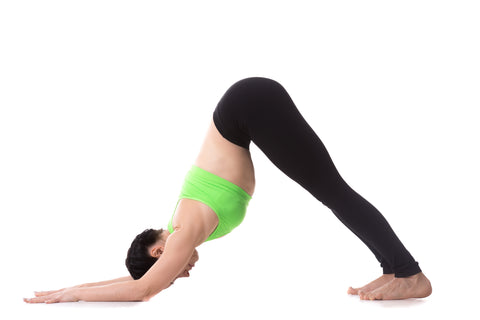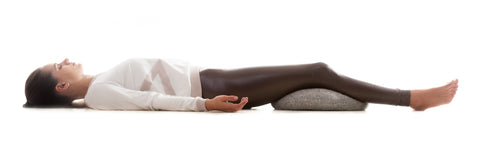Holiday season is just around the corner, bringing that “Christmassy” feeling and many cherishing moments with family, friends, and loved ones. Smell the cinnamon and orange, listen for sleigh bells in the snow and get stabbed in the toes by a million pine needles! It’s going to be a lot of fun!
In a couple of weeks we'll have forgotten about all those hours at the shops zig-zagging around pavements, deciding who’s to be your third person in your 3 for 2s and the declarations of being completely in control, only to forget the cranberry sauce twice!

You may practice yoga all year long to find joy and peace, yet when the holiday season arrives, a festival devoted to joy and peace, these words are the last thing on your mind while dashing round the shops. With only a few days remaining and a possibly mounting list of things to get in place we thought it an apt time to remind you to stop, breathe and be present. We all want to buy someone the perfect gift, host the perfect meal and create a warm and merry ambience in our homes on Christmas day. But often we reach Christmas day burnt out from a list of “must-haves” that build stress upon stress to the point of overwhelm.
Take control of your stress this Christmas and soothe it away each day with just a few minutes practicing yoga. Try the 4 poses below and see for yourself how they can help boost your energy and turn irritation and impatience into mental clarity and rejuvenation.
So from now on, holidays are just for fun, no tension, no stress, no worries.
Wishing you and your loved ones a wonderful Christmas and New Year!
Your Stress Busting Sequence
Time
Each pose will take approximately 2 minutes. This sequence is designed to build up to a peak pose and wind down to a restful finish. We recommend completing the full sequence in the order set out below to achieve optimum results and minimise injury. Always finish with Savasana to help you keep calm presence and focus throughout the rest of your day. Set a timer so you can focus on savouring each moment of stillness and slow down your breathing rhythmically.
Props
We recommend you use a mat for comfort and traction. For pose variations, additional props may be required.
Poses
1. Dolphin Pose - Ardha Pincha Mayurasana
A variation on Downward Dog that is softer on the wrists.
This pose is aimed to strengthen the arms in preparation for the headstand.
Benefits:
Can provide relief for:
- Stress
- Anxiety
- Fatigue
- Headaches
- Insomnia
- Mild depression
- Brain Fog
- Digestive issues
- Back pain
- Menstrual discomfort
- Asthma
- Sinusitis
- Flat feet
Instructions:
- Begin on your hands and knees with your wrists directly below your shoulders and your knees directly below your hips.
- Lower your elbows to the floor directly below your shoulders. Keeping both forearms parallel and forward facing, distribute your weight evenly across your forearms.
- Raise your heels from the floor and tuck your toes then lift your knees off the floor. Lift your pelvis upward and lengthen your spine keeping the back straight whilst gently walking the feet towards your hands until both hands are straight and your torso and legs form an "A" shape. The position should be comfortable with toes on the floor and heels raised at a 45 degree angle to the floor. Feel the extension through both the back and the legs.
- Align your ears with your upper arms and relax your head in position.
- Draw your shoulder blades back toward your tailbone to widen across your collarbones.
- Hold the pose for 5-25 breaths.
- To release the pose, on an exhalation gently bend your knees and come back to the floor. Press back into Child's Pose (Balasana) to rest.
Modifications & Variations:
To open the shoulders even more: Press your palms together with your forearms on the floor. Continue pressing your palms, or clasp all ten fingers together.
If your upper back rounds when you straighten your legs: Bend your knees again until you gain enough flexibility in your spine to keep it long and straight throughout the pose.
Care:
Avoid practicing Dolphin Pose if you have high blood pressure, infections of the eye or inner ear or have had a recent or current shoulder, back, arm, or neck injury.
2. Child’s Pose - Balasana
Resting position in between more difficult poses. Warm up for deep forward bend.
Benefits:
Can provide relief for:
- Stress
- Fatigue
- Back and neck pain
- Shallow breathing
Instructions:
- Begin on your hands and knees with your wrists directly below your shoulders and your knees directly below your hips.
- Lower your elbows to the floor directly below your shoulders. Keeping both forearms parallel and forward facing, distribute your weight evenly across your forearms.
- Raise your heels from the floor and tuck your toes then lift your knees off the floor. Lift your pelvis upward and lengthen your spine keeping the back straight whilst gently walking the feet towards your hands until both hands are straight and your torso and legs form an "A" shape. The position should be comfortable with toes on the floor and heels raised at a 45 degree angle to the floor. Feel the extension through both the back and the legs.
- Align your ears with your upper arms and relax your head in position.
- Draw your shoulder blades back toward your tailbone to widen across your collarbones.
- Hold the pose for 5-25 breaths.
- To release the pose, on an exhalation gently bend your knees and come back to the floor. Press back into Child's Pose (Balasana) to rest.
Modifications & Variations:
Difficulty resting your buttocks on your heels: Place a thick folded blanket between your calves and the backs of your thighs.
Deeper stretch in the hips: Spread the knees wider apart, making sure you are comfortable when extending deeper into the pose.
Uncomfortable on the tops of your feet: Pad the tops of your feet by placing a blanket or folding your mat under them.
Forehead unable to reach the floor: Place a firm pillow, bolster, or stack of blankets under your forehead or make fists and stack your hands under your forehead.
Care:
Avoid Child's Pose if you have a current or recent knee injury. During pregnancy, women should only practice a wide-legged variation.
3. Head to Knee Pose - Janu Sirsasana

A forward bend with a subtle twist.
Benefits:
Can provide relief for:
- Anxiety
- Fatigue
- Insomnia
- Mild depression
- Digestive troubles
- Menstrual discomfort
- Menopause symptoms
- High blood pressure
Instructions:
- Begin seated in Staff Pose (Dandasana); upright with both legs extended straight out in front of you.
- Bend your left knee and bring the sole of your left foot to touch your inner right thigh.
- Gently twist your torso to align with your right leg. Keeping a long spine, exhale as you bend forward from the hips over the extended right leg. Reach the stomach then the chest towards the right thigh, leading from the torso not the nose. Your nose should touch your leg last. Press down through the left heel to engage the left leg.
- Lengthen the torso with each inhalation and folder deeper with each exhalation.
- Hands can hold on to the right calf or foot or allowed to fall to the floor either side of the extended leg. Keep your shoulders back and avoid the inclination to collapse the chest and round the spine in an effort to move deeper into your fold.
- Hold the pose for 5-10 deep breaths.
- On an inhale, slowly ascend back to an upright position. Repeat on the other side, bending the right knee.
Modifications & Variations:
Tight hamstrings or lower back: Place a rolled-up blanket or yoga mat beneath the knee of your extended leg.
Unable to comfortably grasp the foot or ankle of your extended leg: Wrap a yoga strap around the sole of the extended foot and grip it with both hands, arms fully extended. As you start to open up, walk your hands gently along the strap. Avoid using the strap to pull your upper body forward.
Finding it easy to clasp your hands around the sole of your extended foot: Deepen the pose by placing a yoga block against the sole the foot and reach your fingers around it
Needing a greater challenge: Widen the angle between your legs beyond 90 degrees before executing the pose.
Care:
Aim to keep your torso long throughout the pose. Touching your head to your knee is not the most important aspect of the pose. Over-rounding the spine to achieve this can cause injury. Be sure to take it slowly and never force yourself in the pose. This will only cause more stiffness and resistance. With regular practice, your hamstrings and groins will loosen up.
This pose is better practiced toward the end of a sequence, when the body is warm, to prepare the body for even deeper forward bends.
4. Corpse Pose - Savasana
A deepened state of awareness.
Benefits:
Can provide relief for:
- Anxiety
- Stress
- Fatigue
- Insomnia
- Mild depression
- Headaches
- High blood pressure
Instructions:
- Sit on the floor with both knees bent upward and feet on the floor. Lean back onto your forearms, lift your pelvis off the floor slightly while laying your back against the floor to ensure the spine is fully elongated before returning the pelvis to the floor. Rest your hands about six inches from your body with palms facing up.
- On an inhale, slowly extend the right leg, then the left, pushing from the heels until both legs lie relaxed on the floor angled evenly from the centre axis of the torso with feet turned out equally.
- Close your eyes and let your breath occur naturally. You may wish to cover your body with a blanket.
- Working upward from the soles of your feet to the crown of your head, progressively focus your attention on each area of your body. The aim is to check in with each part of the body in turn with complete awareness and acceptance of how it feels. Tension will be released through acceptance which will allow your body to feel heavy against the floor.
- Relax your face and the skin on your forehead, loosen the root of the tongue, the wings of the nose and the inner ears. Let the eyes sink to the back of the head.
- Stay in this pose five minutes for every 30 minutes of your practice.
- To release the pose, on an exhalation roll gently onto your right side, resting there for a moment, before pressing your hands against the floor and slowly lifting your torso, followed by your head, into a seated position. Wiggle your fingers and toes to regain movement in the body. Bring forth the peace and stillness of savasana into your day.
Modifications & Variations:
Difficulty lying on your back comfortably: Place a bolster underneath your knees to take the weight off of your pelvis and allow the lower back to release and relax.
Pregnancy: Women who are pregnant should not lie fully flat in Savasana. Instead, rest the torso, with the chest and head avobe the belly, on a bolster or a stack of firm pillows or blankets.



